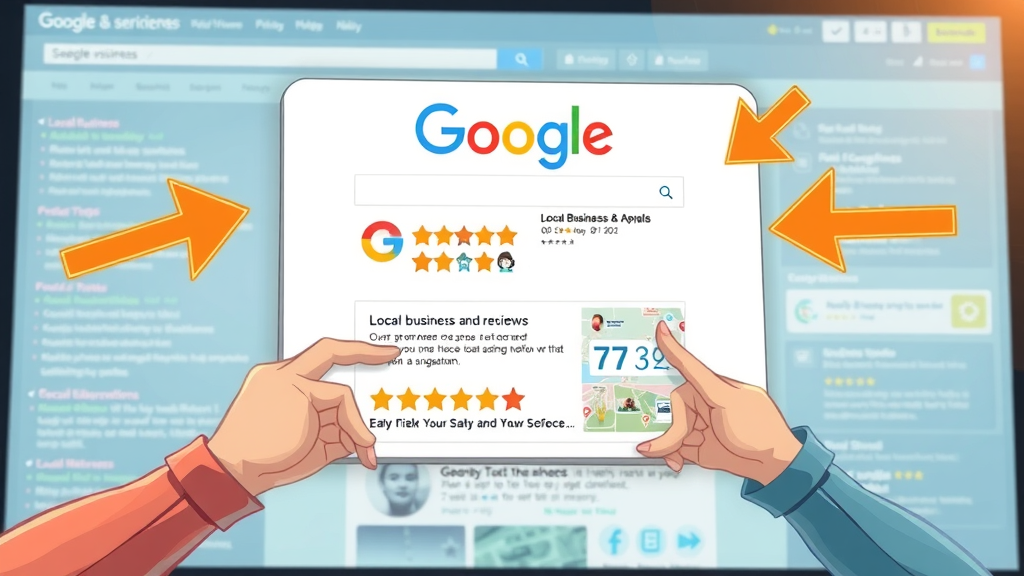Did you know that nearly 88% of consumers trust online reviews as much as personal recommendations ? That’s right—whether you run a cozy coffee shop or an established HVAC business, how you handle getting customer feedback and Google reviews for local brick & mortar and service-based businesses can make or break your sales. In this comprehensive guide, you’ll discover exactly how powerful genuine feedback can boost your business profile, improve Google Business Profile rankings, and supercharge your local business growth—fast. Stick with us to uncover real-world tactics, pitfalls to avoid, and insider tips that you can implement today to start seeing results. Ready to unlock the full sales potential of your customer reviews? Let’s dive in.
Unlocking Growth: Why Getting Customer Feedback and Google Reviews Is Essential for Local Businesses
"Nearly 88% of consumers trust online reviews as much as personal recommendations—demonstrating the power of getting customer feedback and Google reviews in influencing buying decisions."

- Discover how your business profile and google review presence can lead to increased sales, stronger online visibility, and higher local business trust.
For any local business, whether you serve customers face to face or in service areas, a strong online reputation is critical for success. In an age where your business address is often judged by its digital footprint, customer feedback and Google reviews act as social proof, giving potential customers confidence in your products and services before they ever set foot in your store or book an appointment. A steady flow of positive reviews does more than boost your star rating—it directly influences local search results and increases the likelihood that a new customer will choose you over a competitor.
When customers leave authentic feedback, they’re not just sharing their experience—they’re shaping your online reputation in a tangible way. Online reviews also reveal what’s working (or not) in your customer service, acting as a free assessment for your team. The more feedback and Google reviews you gather, the richer your insights into customer needs, enabling continuous improvement across your product or service offerings. By placing feedback at the center of your local business review strategy, you can stand out in crowded service areas and become the business of choice in your community.
What You'll Gain from Improving Your Google Business Profile Feedback Strategy
- Understand how to collect and utilize customer feedback for your google business profile.
- Learn actionable steps to increase your google reviews and overall local business reputation.
- Find out how to optimize your service area presence and online reviews.
- Identify strategies to encourage customers to leave valuable google review feedback.

Optimizing your feedback strategy doesn’t just improve your star rating; it directly elevates your business profile, impacting both how search engines and real customers perceive you. With each positive review, your google business profile becomes more appealing in local search results, while critical feedback provides invaluable direction for business improvement. By mastering how to collect and utilize customer feedback , you lay a foundation for continuous growth and loyal customer relationships.
Through this strategic approach, you’ll also foster a vibrant customer base, expand your service area reach, and minimize the risk of negative surprises. Training your staff to request feedback and respond openly will turn every interaction into an opportunity. Expect to see increased service area engagement, more repeat customers, and a steady stream of glowing reviews that set your business apart in any area business directory.
How Getting Customer Feedback and Google Reviews Impacts Your Google Business and Service Area Rankings
The Link Between Google Reviews and Google Business Profile Visibility

There’s a clear connection between google reviews and your google business profile ’s visibility in local search results. Businesses with a healthy volume of current, high-quality online reviews consistently outrank those with a sparse or outdated review history. Google’s local search algorithm rewards feedback by factoring both the quantity and recency of customer reviews into your local business ranking—meaning every authentic review strengthens your presence.
A robust review portfolio can help your business profile appear in the coveted “local pack,” that three-business section at the top of area search results, amplifying your exposure. More reviews signal both activity and credibility to Google, distinguishing you from competitors whose reputation is less developed. In short, focusing on getting customer feedback and Google reviews for local brick & mortar and service-based businesses leads to better rankings, more clicks, and ultimately, more foot traffic or service area calls.
How Customer Feedback Enhances Local Business Ranking in Your Area Business Listings
"The quantity, quality, and frequency of your online reviews can directly impact rank for local search and area businesses."
Customer feedback does more than build trust—it actively shapes your business profile within area business listings and directories. Review volume and consistency are critical components Google uses to position your service business in results for your targeted service areas and business location. If your profile stays current with regular feedback and responses, it signals that your business is engaged and reliable.
Moreover, detailed feedback provides rich, keyword-driven content—naturally boosting your online presence and making your business easier for search engines to understand and promote. For businesses hoping to develop a bigger footprint in their community, encouraging a steady stream of reviews makes your service area or local business more discoverable and trusted in online directories—unlocking greater growth potential.
Optimizing Your Google Business Profile for More Customer Feedback and Google Reviews
Setting Up and Verifying Your Google Business Profile for Local Businesses

The first step in unlocking the power of customer feedback is a fully optimized and verified google business profile . Claiming and verifying your GBP listing enables you to manage how your business appears in local search, update your business address or service area, and respond directly to reviews. Verification typically requires a simple postcard, phone, or email process, but it’s a crucial security measure to ensure only real business owners control the profile.
Once verified, take time to fully complete your business profile. Upload professional photos, set accurate hours, and provide detailed descriptions of your products and services. Remember, businesses with complete and up-to-date profiles attract more customers and receive more reviews—making this a powerful first move for both brick & mortar locations and service-based businesses operating in multiple service areas.
Ensuring Your Service Area Information Is Accurate
If your business serves customers across multiple service areas or doesn’t have a traditional storefront, accurate service area details are essential. Clearly list every location you serve and ensure your business address, contact information, and service descriptions are current. This not only helps customers find you more easily but also ensures that your business appears in relevant local search results.
Errors or omissions in your Google Business Profile service area settings can cause your business to be overlooked by potential customers looking for your products and services nearby. Review these details regularly to keep your online presence—and local business review opportunities—maximized.
Making Your Google Business Page Inviting for Customer Feedback
Customers are more likely to leave feedback on an inviting and engaging Google Business Page. Use high-quality photos, update business hours often, and enable messaging if possible. Posting updates about new products, service changes, or community involvement keeps your profile active and shows customers that you value their engagement.
Promptly respond to reviews (both positive and negative), which demonstrates your commitment to customer service and builds further trust. An active profile not only drives more reviews but also encourages higher involvement from your loyal customer base—advancing both your service area and local business visibility.
Effective Strategies for Getting Customer Feedback and Google Reviews for Local Brick & Mortar and Service-Based Businesses
How and When to Ask Customers to Leave Google Reviews
- In-person requests at point-of-sale or service completion
- Follow-up email or SMS with review request link
- Incentivizing honest feedback (without paying for reviews)
- Staff training in customer service and review request etiquette.

Timing and approach make all the difference when asking for reviews. A well-timed, friendly request right after an excellent service or sale greatly increases the odds that customers will leave valuable feedback. Teach your team to confidently ask for a Google review at the register, after a satisfying meal, or upon job completion—whenever the customer is most satisfied and likely to share a positive experience.
Follow up after the purchase or service with a personalized email or text message, including a direct link to your Google Business Profile. This makes the review process convenient and quick—reducing the friction for even busy customers. Remember, the key to getting more reviews lies in consistency across your staff and customer service touchpoints. By embedding review requests into your customer interactions, you’ll see a natural increase in both the quantity and quality of online reviews.
Leveraging Social Media and Your Website to Encourage Google Reviews

Social media and your website are powerful tools for amplifying your call to action for reviews. Including a “Leave Us a Google Review!” link on your homepage, product pages, and thank-you messages can dramatically increase review volume. Regularly remind followers on Facebook or Instagram how much their feedback means—not just for your business, but for helping other potential customer connections find you.
Share screenshots of glowing reviews, celebrate reaching new star rating milestones, and thank individual reviewers publicly (with permission). This transparency inspires more customers to leave their own positive message, further fueling your online reputation and strengthening community ties in your service areas.
Using QR Codes and Short Links for Easy Access to Your Business Profile

Remove barriers for customers to leave a review by integrating QR codes and short links into high-visibility locations—on your checkout counter, printed receipts, invoices, and signage. With QR codes, customers can instantly access your business profile on their smartphones while their positive experience is still fresh.
This hassle-free access ensures that even those less familiar with Google reviews can still participate, widening your net for authentic feedback and enhancing your business profile across your service areas. Regularly refresh your QR codes and links to reflect any updates to your Google Business Profile, especially if you expand into new area business markets or add locations.
Best Practices for Responding to Customer Feedback and Managing Google Reviews
Responding to Both Positive and Negative Google Reviews

Thoughtful responses to both positive and negative reviews are essential for showcasing your commitment to excellent customer service. Acknowledge every review with gratitude—even if it’s just a quick “thank you”—and personalize your message to show the reviewer that their experience matters. For negative reviews, always reply with empathy and a solution-oriented mindset. Publicly inviting unhappy customers to contact you directly can turn an unhappy encounter into a repeat visit.
Managing your online reviews transparently not only addresses individual concerns but also demonstrates to all potential customers that your local business values feedback and strives for excellence. Responding promptly and professionally fortifies customer trust and may even boost your google business profile ranking as Google sees engagement as a positive ranking signal.
Turning Customer Feedback into Service Enhancements
Each review is a roadmap for improvement. Analyze feedback trends—both positive and negative—to identify strengths and address recurring pain points in your products and services. By making visible changes based on reviews (and letting customers know you’re listening), you reinforce the value of customer feedback and inspire even more to share their opinions.
This continuous improvement cycle fosters a loyal customer base and helps position your local business or service area as a standout in quality and service—directly influencing growth and future sales.
Monitoring, Tracking, and Reporting for Customer Feedback and Online Reviews
Tools and Services for Monitoring Google Reviews and Customer Feedback
| Tool Name | Key Features | Suitable For | Price |
|---|---|---|---|
| Whitespark | Review monitoring, citation tracking, reporting | Small, multi-location, service business | Starts at $25/mo |
| Birdeye | Automated review requests, response management, analytics | Local business, franchises, service areas | From $299/mo |
| Google My Business App | Free direct review management, real-time notifications | All business types | Free |
| Reputation.com | Multi-platform monitoring, enterprise solutions, social integration | Service business, enterprises | Custom pricing |
Regularly tracking your reviews on Google and other platforms is key to maintaining a healthy online reputation. Using automated tools streamlines the process and ensures you never miss vital feedback. These solutions can also provide actionable insights—like common keywords, sentiment, and performance across different service areas—helping inform smarter decisions for your business profile.
With effective tracking, your team can spot trends, react quickly to negative reviews, and celebrate exceptional customer service—ensuring that every piece of feedback leads to actionable improvements and stronger search results in your target business location.
Measuring ROI from Getting Customer Feedback and Google Reviews

The return on investment for prioritizing online reviews can be measured in several ways: increased sales, higher star rating, better customer retention, and improved placement in local search results. By tracking metrics such as review quantity, sentiment, traffic to your Google Business Profile, and conversion rates, you can directly connect your feedback efforts to tangible growth.
Over time, strong ratings and a steady flow of customer feedback directly enhance your customer base and local business trust. Businesses that consistently monitor these metrics create a positive cycle—higher visibility brings in more customers, which in turn leads to more reviews and even better rankings in both service area and area business listings.
Common Pitfalls to Avoid in Getting Customer Feedback and Google Reviews for Local Businesses
Violating Google Policies on Customer Reviews
It’s tempting to take shortcuts, but Google’s strict policies on review solicitation must be respected. Avoid offering incentives, discounts, or any form of payment for reviews—violating these rules can lead to reviews being removed, your business profile being suspended, and permanent loss of credibility.
Always encourage genuine, voluntary feedback and focus on delivering top-tier customer service as your best review-generation strategy.
Overlooking Negative Feedback in Your Google Business Profile
- Never offer payment for reviews
- Don't ignore or delete negative reviews
- Always use transparent and ethical review solicitation methods
Ignoring or deleting negative reviews damages your credibility far more than the review itself. Instead, treat negative feedback as an opportunity to learn and improve. Respond to every negative review with empathy, a willingness to address the issue, and a public show of customer service commitment.
This honest, transparent approach not only preserves but can also elevate your online reputation, showing potential customers that you stand by your business and value every customer’s experience.
Step-by-step visual walkthrough on collecting and optimizing Google reviews, featuring real-world customer interaction examples, on-screen action pointers, and best practice tips.
Case Study: Transforming a Local Service Business with Customer Feedback and Google Reviews
"After implementing review request strategies, our service area business saw a 30% increase in new customers from online search."
- Challenge: Low review volume and poor visibility
- Solution: Automated follow-ups & training staff to ask for reviews
- Results: Boost in star rating, more service area customers, and improved google business profile ranking
This case study illustrates the power of a well-executed feedback strategy. By leveraging review request automation and empowering staff to openly ask every satisfied customer for a Google review, one local service business outperformed competitors in a crowded area business market. The outcome? A dramatic increase in both customer base size and local search visibility—ultimately driving more sales from previously untapped service areas. It’s proof that getting customer feedback and Google reviews for local brick & mortar and service-based businesses can be a game-changer in today’s market.
Lists of Proven Tips for Generating More Customer Feedback and Google Reviews for Local Business
- Train all staff to request reviews at critical touchpoints
- Personalize follow-up requests based on customer experience
- Add a review request link to your email signature and invoices
- Prominently display QR codes linking to your google business profile
- Respond to every review, showing appreciation for feedback
Consistency is the cornerstone of any successful review generation campaign. Equip your entire team—not just front-line staff—with best practices for confidently requesting feedback. Integrate review requests into every aspect of your customer journey, from the first greeting to the final invoice. Remember, the easier you make it for customers to leave feedback, the more likely they’ll help you build an unbeatable online reputation.
How Getting Customer Feedback and Google Reviews Builds Trust and Loyalty in Service Areas
The Impact of Positive Local Business Reviews on Community Perception

Positive online reviews create a ripple effect in your community. When residents see that a local business consistently receives glowing review feedback, they equate it with reliability, quality, and trustworthiness. This reputation not only encourages new customers to try your services but also solidifies your existing customer base—turning casual shoppers into loyal advocates.
Over time, the steady accumulation of positive reviews positions your business as a pillar in the local area—supporting word-of-mouth referrals and drawing in new area business from both online search and community recommendations. In essence, reviews are a form of community validation, reinforcing your business’s standing across all your service areas.
Leveraging Customer Testimonials for Service Area Marketing
Customer testimonials, drawn from authentic online reviews, are marketing gold. Featuring these stories on your website, social media, and print materials deepens the emotional pull for potential customers in your target service areas. Always secure permission to share testimonials and consider including a headshot or “thank you” follow-up to personalize the story.
This approach builds both trust and relatability, setting your business apart from larger, impersonal chains in the eyes of the community. The end result? More inbound leads from your service area and deeper loyalty from existing customers who feel seen and valued.
Answers to Popular Questions about Getting Customer Feedback and Google Reviews
What is the best way to get Google reviews from customers?
The best method is to ask directly and make it easy—whether in person at the point of service, via follow-up emails or text messages with a direct review link, or by providing a QR code at your business location. Consistency and timing are key, and always ensure your request is framed as a way to improve service for both the reviewer and the community.
Where do I find Google reviews for a business?
You can view a business’s Google reviews by searching for the business name in Google Search or on Google Maps, then clicking on the reviews section attached to their Google Business Profile. This area displays all public reviews left by customers, including ratings and detailed feedback.
How to set up Google reviews for a small business?
Start by claiming and verifying your Google Business Profile at the Google Business website. Once your profile is fully set up and verified, customers can leave reviews through your business listing. Share your direct review link to encourage more customers to contribute feedback and grow your online reputation.
Can you pay people to review your business?
No, Google’s guidelines prohibit paying for reviews or offering incentives in exchange for positive feedback. Violating these policies can result in your reviews being removed or your profile being suspended. Always pursue honest, organic reviews for lasting credibility and trust.
Frequently Asked Questions
-
Is it enough to have a Google Business Profile without reviews?
No—while having a profile is essential, reviews add trust and improve your chance of appearing in local searches. -
How often should I ask for reviews from my service area customers?
Regularly ask after every positive customer service interaction, making it a natural part of your business routine. -
Can negative feedback on Google help my business?
Absolutely—negative reviews highlight improvement opportunities and, if handled well, can actually build trust with potential customers. -
What tools are best for tracking online reviews and customer feedback?
Dedicated tools like Whitespark, Birdeye, and the Google My Business App provide comprehensive review tracking and reporting features.
Key Insights on Getting Customer Feedback and Google Reviews for Local Brick & Mortar and Service-Based Businesses
- Getting customer feedback and Google reviews is vital for local business trust, better area business rankings, and acquiring new service area customers.
- Consistency, authenticity, and responsiveness set top-performing local businesses apart.
- Use technology and staff training to streamline review requests and management processes.
Ready to Start Getting Customer Feedback and Google Reviews for Your Business?
Ready to turn customer feedback into growth? Get a Free Reputation Audit and start building a stronger reputation that brings in more local business. Don’t wait—your next glowing review could be the one that sets you apart in your service area!
To enhance your understanding of gathering customer feedback and Google reviews for local brick-and-mortar and service-based businesses, consider exploring the following resources:
-
“8 Techniques To Get More Customer Reviews For Your Local Business” : This article outlines practical methods such as collecting email addresses during billing and using in-store signage to encourage reviews. ( searchenginejournal.com )
-
“11 Tips to Get More Google Reviews for Your Local Business [Start Today!]” : This guide offers actionable strategies, including making it easy for customers to leave reviews and utilizing QR codes in your store or office. ( ricketyroo.com )
By implementing the strategies discussed in these resources, you can effectively boost your online presence and attract more customers to your business.
 Add Row
Add Row  Add
Add 




Write A Comment